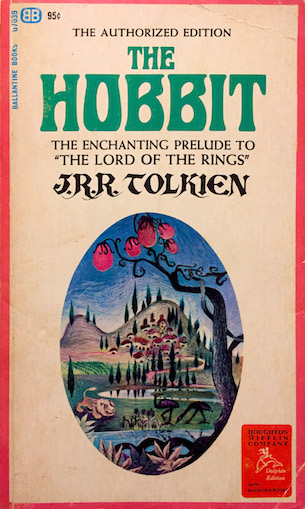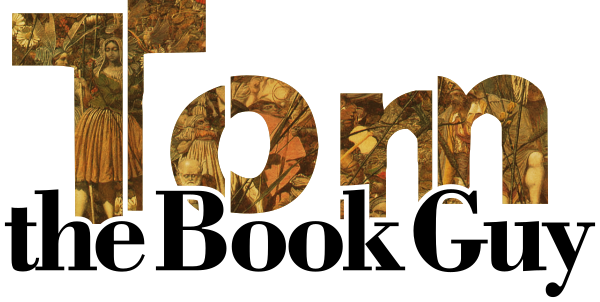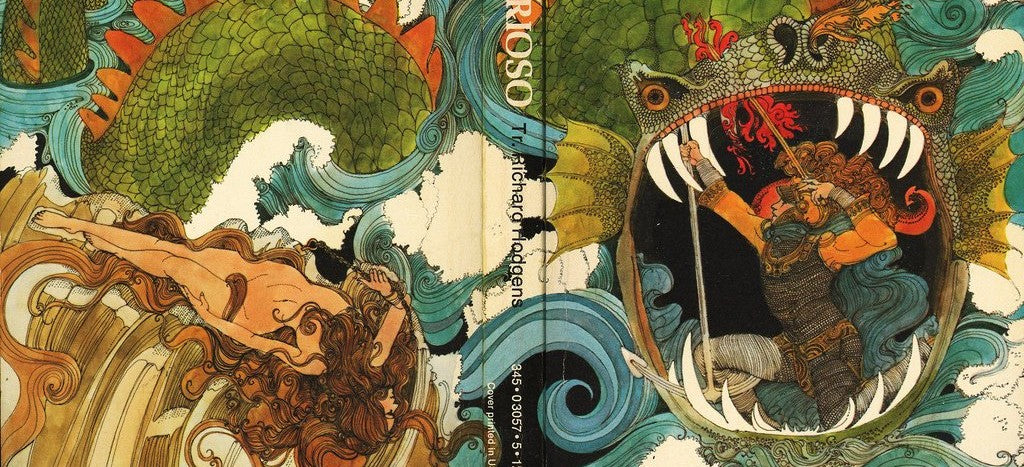Originally posted on our old wordpress blog in October 2016, with a couple edits and additions:
To people who want to read the recent best sellers but don’t want to pay full price for the hardcover, all mass market paperbacks are desirable… to begin with. They are designed that way; to be within the price range of the widest possible audience. You still need an eye-catching cover and decent typography, but the production values are significantly less. After a year or two, chances are prices will have gone down so much that you might as well buy the hardcover used for the same price as the paperback (it’s not unusual online that it’ll cost one penny plus shipping), and the paperbacks just get thrown by the wayside. The spines get lined and creased, the pages dog eared, coffee gets spilled over them, etc.
But there are exceptions.
One set of paperbacks that I love and collect are the old Ballantine Adult Fantasy, started in the 1970s due to the sudden popularity of Tolkien. Editor (and author) Lin Carter wanted to bring to light all of the great works of fantasy that were published prior to Tolkien’s epics, at affordable cost. And there are more than you’d think, and so many of really great quality. Tolkien certainly didn’t invent the genre, it’s just that his work is so huge that anything before him gets forgotten. These books also have beautifully illustrated covers that span the front and back covers, and recognizable by the unicorn colophon. Lin Carter wrote introductions to almost every single book.
That line is a rarity in terms of curation and design – 60+ collectible, gorgeous paperbacks of great books, all of a set. Most of them you can pick up for a few dollars, but there are a select few that go for more.
update: How can I have forgotten about the unauthorized/pirated Ace editions of The Lord of the Rings? These came out in 1965 just a few years prior to the BAF (Ballantine was the first official American publisher of Tolkien). These three paperbacks are recognizable by their bright red, yellow, and blue covers respectively. Not surprisingly, Ace was threatened with legal action. The controversy was real, but the publicity was also very real and very much helped popularize the books in the US. Not easy books to find in nice condition, and only increasing in value as the years go by. Read more about the publication history at Kirkus Reviews. And a further article from whence the following image came:

...and then of course we have the first offical paperback printing of The Hobbit and the Lord of the Rings in the US through Ballantine by the artist Barbara Remington who infamously didn't, or wasn't able to, actually read the books beforehand. The covers are beloved by many, but Tolkien couldn't let the first version of The Hobbit stand as it was. Ain't no lions in The Hobbit. There are many other similar issues but a lion was a step too far. The lion was quickly excised from the cover leaving a patch of grass, but can still be found on the earliest printings:

You can read more about that over on The Tolkien Collector's Guide.
Let me get to the oddballs, the ones you wouldn’t think had value just by looking at them:
The four early books by Richard Bachman… aka Stephen King. In the late ’70s and early ’80s, he wanted to know whether he could still sell well under a pseudonym. Spoiler – he did not, and so the print runs for the early editions were small until the truth came out. Just think of J.K. Rowling’s experiment of writing as Robert Galbraith. The Bachman books, later collected in one volume:
- Rage (1977)
- The Long Walk (1979)
- Roadwork (1981)
- The Running Man (1982)
You might recognize The Running Man from the film version (1987) starring Arnold Schwarzenegger. Rage? Probably not so much, unless you’re a super Stephen King fan. In fact, he let the book fall out of print because it deals with school shootings. When your book starts being blamed (rightly or wrongly) as inspiration for similar acts in the real world, it’s understandable that you’d want to distance yourself from it.
The first paperback printing of The Princess Bride by William Goldman. Why? Well, because it’s a first of a book that remains popular, and because of the unusual cover that has absolutely nothing to do with the story! I love the cover but it really makes no sense at all. So the book is a curiosity and has value because of it.

The Invincible by Stanislaw Lem. A Polish science fiction author best known for Solaris. Usually books are published in hardcover first, but back in the ’60s and ’70s science fiction publishers weren’t the big business they are now, and more often the first editions/first printings are the mass market paperbacks.

Killing Time by Della Van Hise. A Star Trek book. One of hundreds, albeit in an alternate universe. First published in 1985. The first printings are desirable because of the homoerotic content between Kirk and Spock which was later edited out. Basically, there was too much touching and descriptions of their physical reactions to one another.

I’m forgetting some, for sure, and there are probably dozens that I don’t know anything about! Honorable mentions, however, go to the vintage pulp fiction of the early 20th century. There’s just something about those sensational covers! You just can’t recreate a style like that without being nostalgic, or ironic. Not possible. Simply because they were printed cheaply means that it’s difficult to find these in decent condition, and people were less likely to stockpile them on their shelves (also the reason early comic books are so scarce and valuable).
I should give a shout-out to the ASE (Armed Services Editions) books of the mid-1940s. These are small, horizontal pocket-size paperbacks that were produced cheaply and sent freely to troops overseas. All topics and genres were covered, mostly unabridged. The slogan was “Books are weapons in the war of ideas” (how cool is that?). I believe these books were also instrumental in making mass market paperbacks popular, especially once those soldiers started coming home.
For publishers these days, the new mass market paperback is… the ebook – I wonder if the ebook will ever supplant the mass market paperback. Make no mistake, an ebook still needs production values, but once it’s done it is also endlessly reproducible and the extra copies won’t take up space in the warehouse. There is huge disagreement in the industry as to best practices for pricing ebooks, because you can sell them for .99 cents with minimal loss (in terms of production), but what does that say about the intrinsic value of the book? How many copies do you have to sell before you break even for the publisher and author? Not everyone is going to pay .99 cents for a book just because it’s a book, but you might have enough people interested in the book that selling it for $9.99 would be more profitable even if you sell significantly fewer copies. And what effect does the ebook have on the intrinsic value of print books? Are ebooks responsible for the devaluing of print books, or is Amazon to blame above and beyond? …but these are tangential questions.
In the used books business, there are always exceptions to the rules. You can be pretty damn confident that 99.99% of mass market paperbacks aren’t worth the paper they’re printed on (in terms of resale value), but there are these few strange exceptions. You can be exponentially more sure that Reader’s Digest Condensed Books have no value, and that old National Geographics aren’t worth your time. Self help, cook books have a few notable exceptions, but old fad diet books probably won’t ever. But people are fickle, and who knows what will be popular in 20 years.
Mass market paperbacks can be a joy to collect for many reasons, one of which is precisely that they are affordable, and also simply that they are smaller and less heavy than hardcover.

